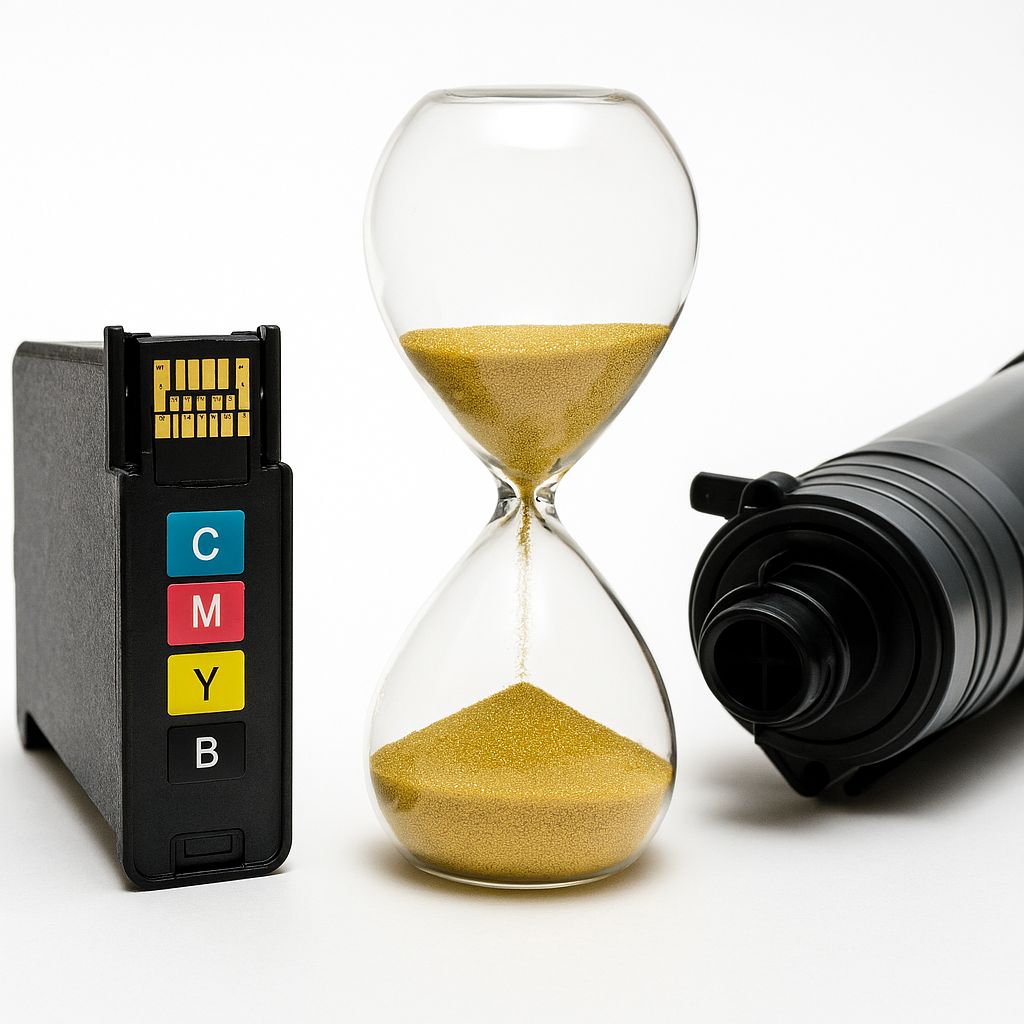How Long Does an Ink or Toner Cartridge Last?

Everyone who uses printers—whether at home or in the office—has wondered at some point how long an ink or toner cartridge lasts. The answer isn’t always simple, because there’s a difference between shelf life (the time a sealed cartridge remains functional in its box) and usage life (the time it works properly once installed in the printer). Additionally, there are major differences between inkjet inks and laser toners.
In this detailed guide we’ll cover:
-
How long ink and toner cartridges really last.
-
What affects their lifespan.
-
Best storage practices for maximum performance.
-
When you should replace a cartridge.
And of course, how to choose reliable cartridges from Printking for guaranteed quality.
How Long Do Ink and Toner Cartridges Last?
-
Ink cartridges (inkjet):
-
Sealed: 18–24 months.
-
Opened/installed: up to 6 months (especially with infrequent printing).
-
-
Toner cartridges (laser):
-
Sealed: 24–36 months.
-
Opened: ideally used within 6–12 months.
-
Proper storage in a cool, dry, and dark place, keeping the cartridge in its original packaging and upright, can significantly extend its life.
Shelf Life vs. Usage Life – Why It Matters
-
Shelf life: The period during which a sealed cartridge stays fully functional and within manufacturer specs. Influenced by materials and storage conditions.
-
Usage life: The time a cartridge works properly once installed. This is shorter since ink is exposed to air or toner powder begins circulating.
Ink Cartridges (Inkjet)
Ink cartridges are more sensitive than toners because they contain liquid.
-
Sealed: Usually last 18–24 months. After 2 years, ink quality may degrade.
-
Opened: Once installed, they should be used within 3–6 months. Ink may evaporate, thicken, or clog nozzles.
Why does ink go bad?
-
Evaporation reduces liquid volume.
-
Pigment sediment clogs nozzles.
-
Temperature changes alter consistency.
Toner Cartridges (Laser)
Toners last longer since they contain dry powder—but they are not eternal.
-
Sealed: 24–36 months with proper storage.
-
Opened: Should be used within 6–12 months, as humidity may cause clumping.
Why does toner degrade?
-
Rubber seals and gaskets wear out.
-
Poor storage may cause clumps.
-
Drums may develop lines over time.
Factors That Shorten Lifespan
-
Temperature above 30°C or extreme cold.
-
Humidity causing ink thickening or toner clumping.
-
Light/UV damaging materials.
-
Orientation—ink cartridges must be stored upright.
Best Storage Practices
-
Keep cartridges in original packaging.
-
Store upright, don’t press or lay flat.
-
Choose a cool, dry, dark place (not a basement).
-
Avoid fridge/freezer—moisture destroys ink.
-
For opened ink cartridges: store in a zip bag with a slightly damp tissue.
Troubleshooting
-
Ink: If prints show gaps/lines, run printhead cleaning or use special cleaning fluid.
-
Toner: Gently shake to redistribute powder, reinsert. If lines remain, check drum.
Signs a Cartridge Is Bad
-
Ink: Broken lines, fading, error messages, hardened sponge.
-
Toner: Clumped powder, streaks on pages, worn drum.
Buying from Printking
At Printking you can easily find the right cartridge:
-
Filter by printer brand, series, and model.
-
Choose OEM or premium compatible options.
-
Guaranteed quality and proper storage.
-
Fast shipping across Greece and expert support.
FAQ
Do ink cartridges expire?
Yes, typically after 18–24 months, especially if opened.
Do toners expire?
Not exactly, but seals and rubbers age. Store no longer than 36 months.
How should I store them?
In a cool, dry, dark place, always sealed in original packaging.
Does toner dry out?
No, but it can clump due to humidity.
How long does an opened cartridge last?
About 6 months is a safe estimate.
The answer depends on whether the cartridge is sealed or opened, how it’s stored, and whether it’s inkjet or laser. With proper storage, you maximize lifespan.
And with Printking, you know your cartridges are reliable and always ready to print.











